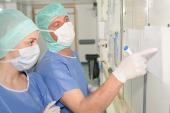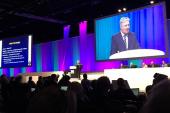CV Care Around Noncardiac Surgery: New ESC Guidelines
The guidelines include new sections on preoperative assessment, antithrombotic therapy, and specific diseases.

BARCELONA, Spain—The European Society of Cardiology (ESC) has issued new guidelines for the cardiovascular assessment and management of patients undergoing noncardiac surgery.
The guidelines, which were published in the European Heart Journal and presented here at the recent ESC Congress 2022. They are endorsed by the European Society of Anaesthesiology and Intensive Care and were drafted with the input of numerous subspeciality organizations and associations.
“Patients undergoing noncardiac surgery are patients who have a lot of comorbidities,” said Julinda Mehilli, MD (Landshut-Achdorf Hospital/Ludwig-Maximilians-Universität, Munich, Germany), co-chair of the ESC task force that wrote the new recommendations.
For example, nearly 60% of these patients will have chronic arterial hypertension, 20% will present with coronary artery disease, 10% will have peripheral or valvular heart disease, 10% will be obese, and 10% will have chronic kidney disease. “And these numbers underestimate the real percentage of these diseases because of the demographic change,” Mehilli told ESC attendees during a deep dive into the guidelines. “The number of people getting older and in need of noncardiac surgery is going to increase.”
The new guidelines include 147 different recommendations, of which 75 are class I and 58 are class II (42 class IIa and 16 class IIb). Of these recommendations, the majority (52%) are based on level of evidence C, which indicates the consensus opinion of experts and/or support by data from small studies, retrospective studies, or registries. One-third of the recommendations are supported by B-level evidence—data from a single randomized clinical trial or large nonrandomized studies—and 12% are based on A-level evidence (multiple randomized trials or meta-analyses).
“This shows us there is a real need for more research in this field,” said Sigrun Halvorsen, MD, PhD(University of Oslo, Norway), who co-chaired the task force with Mehilli.
In terms of what’s novel, Halvorsen said they’ve provided a new flowchart for the general assessment of patients before noncardiac surgery and a new section on the preoperative assessment of patients with newly detected murmurs, dyspnea, edema, or angina. There are revised sections on general risk-reduction strategies, a revised and expanded focus on biomarkers, a revised and expanded section on the perioperative management of antiplatelet and anticoagulant therapy, and a new section devoted to perioperative thromboprophylaxis.
Additionally, the guidelines include advice on patient blood management, directions on how to care for patients with specific cardiac diseases, and a new focus on how to manage cardiovascular risk in cancer patients undergoing noncardiac surgery.
Preoperative Assessments
In general, Halvorsen stressed that perioperative complications are influenced not only by the intrinsic risk of surgery, but also by patient-specific risk factors, such as comorbidities, thrombotic and bleeding risks, and individual risks of hypotension and/or arrhythmia during surgery. While there are numerous scores and calculators, the ESC task force did not recommend a specific presurgical risk score given that many of them underestimate risk, Halvorsen said in the session.
For patients younger than 65 years without CVD or cardiovascular risk factors, a preoperative assessment is only necessary if they’re undergoing a high-risk procedure. For older patients and those with established CVD, a preoperative assessment with ECG and biomarker testing (class I), as well as functional-capacity testing (class IIa), is recommended prior to intermediate- and high-risk noncardiac surgery. This includes checking high-sensitivity cardiac troponin T or I before and after the procedure (class I) as well as BNP or NT-proBNP (class IIa). Functional-capacity assessments needn’t involve exercise testing but can be based on the patient’s ability to climb two flights of stairs. A full cardiology consultation is recommended only for CVD patients undergoing a high-risk surgery.
Task force member Christian Mueller, MD (University Hospital Basel, Switzerland), went into detail about the role of biomarkers in noncardiac surgery, noting that they help quantify the perioperative cardiovascular risk so that physicians can balance those risks with the benefits of surgery.
“We need these tools to have appropriate, informed decision-making with physicians and patients,” said Mueller. With respect to periprocedural MI/injury, 85% of these events are clinically silent and are often neglected or overlooked. “Without active surveillance, we’ll miss them,” said Mueller. “However, they matter. These are silent, neglected killers.”
Given this, the guidelines recommend physicians have a high awareness for perioperative cardiovascular complications, including surveillance for periprocedural MI/injury, in patients undergoing intermediate- or high-risk noncardiac surgery (class I).
Updated and Revised Antithrombotic Recommendations
With pharmacology, routine initiation of beta-blockers preoperatively is not recommended (class III), but the drugs can be continued, along with statins, in patients currently taking them (class I). The task force also provides guidance on use of sodium-glucose cotransporter 2 (SGLT2) inhibitor therapy, stating that it should be stopped for at least 3 days before intermediate- and high-risk surgery (class IIa). In patients without heart failure (HF), stopping ACE inhibitors/ARBs on the day of surgery should be considered to prevent perioperative hypotension (class IIa).
As part of the new guidelines, there was an extensive revision on how to manage patients treated with antithrombotic therapies, said Tobias Geisler, MD (University Hospital Tübingen, Germany).
The need to stop antithrombotic treatment to prevent bleeding depends on the risks associated with different types of noncardiac surgeries. The new guidelines highlight different procedures with minor, low, and high risk of bleeding. For example, surgeries with low risk of bleeding include colonoscopy, hernia repair, or complex dental procedures, while extensive cancer surgery, major orthopedic surgeries, and vascular surgeries are some with a high risk of bleeding.
With antiplatelet therapy, the task force recommends physicians delay elective noncardiac surgery for 6 months after elective PCI and 12 months after ACS (class I). After elective PCI, if noncardiac surgery is more time-sensitive, it’s suggested that patients should be on dual antiplatelet therapy (DAPT) for at least 1 month before the surgery takes place (class I). For high-risk patients with a recent PCI, such as STEMI or high-risk NSTE ACS, DAPT for at least 3 months should be the goal before a more time-sensitive noncardiac surgery (class IIa).
The recommended time interval for interrupting P2Y12 inhibitor therapy prior to noncardiac surgery is 3 to 5 days with ticagrelor, 5 days with clopidogrel, and 7 days with prasugrel (class I). Aspirin can be continued perioperatively in patients with prior PCI if the risk of bleeding is low but should be stopped for at least 7 days in patients undergoing a high-bleeding-risk surgery (class I). Antiplatelet therapy should be started 48 hours after the surgery.
With oral anticoagulation, the guidelines provide extensive recommendations on how to manage treatment in patients depending on the bleeding risks associated with the surgery and the patient’s thrombotic risks. In general, short interruptions of warfarin and non-vitamin K antagonists are recommended, with bridging only recommended for selected patients, such as those with a mechanical heart valve or those at a very high risk of thromboembolic events.
CAD and Other Cardiac Diseases
When it comes to CAD, the new guidelines provide recommendations for how to manage patients with both chronic and acute coronary syndromes. One of the new recommendations focuses on the use of coronary CT angiography to rule out CAD in patients with suspected chronic coronary syndrome or biomarker-negative NSTE ACS who are undergoing nonurgent intermediate- and high-risk noncardiac surgery (class IIa).
In terms of revascularization, routine PCI is not recommended in chronic coronary syndrome patients prior to noncardiac surgery (class III).
During her presentation, Mehilli noted the data are limited in this space and most come from older studies, but they show that revascularization prior to surgery isn’t associated with any improvement in clinical outcomes. In patients with high-risk coronary anatomy, revascularization might be considered in high-risk noncardiac surgery, said Mehilli, depending on the amount of ischemic myocardium, refractory symptoms, and findings on angiography (class IIb).
There are also recommendations for how to manage patients with other specific cardiac diseases in need of noncardiac surgery, such as those with HF, heart valve disease, arrhythmias, peripheral artery disease, and hypertension, among others.
During the presentation, Halvorsen said the task force also developed quality indicators for cardiovascular preoperative assessment and management, where were published recently in the European Heart Journal – Quality of Care & Clinical Outcomes.
“In the future, we will be measured on how good we’re following these recommendations,” she said.
Michael O’Riordan is the Managing Editor for TCTMD. He completed his undergraduate degrees at Queen’s University in Kingston, ON, and…
Read Full BioSources
Halvorsen S, Mehilli J, Cassese S, et al. 2022 ESC guidelines on cardiovascular assessment and management of patients undergoing non-cardiac surgery. Eur Heart J. 2022;Epub ahead of print.
Disclosures
- Halvorsen reports speaking honoraria from Bristol Myers Squibb, Sanofi, Novartis, and Boehringer Ingelheim.
- Mueller reports consulting for several diagnostic companies.
- Mehilli reports lecture fees from Biotronik, SIS Medical, Bayer, Daiichi Sankyo, and AstraZeneca, as well as an institutional grant from Boston Scientific.
- Geisler reports grant/research support and/or honoraria from AstraZeneca, Boehringer Ingelheim, Eli Lilly, Daiichi Sankyo, Bristol Myers Squibb, Pfizer, Edwards Lifesciences, Medtronic, Bayer, Ferrer, Chiesi.





Comments